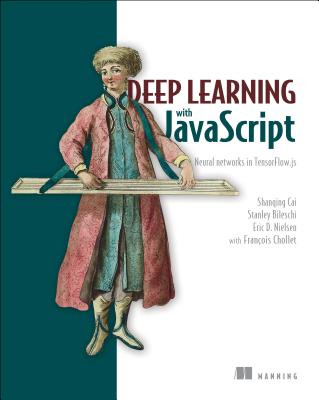買這商品的人也買了...
-
 $2,280Working Effectively with Legacy Code (Paperback)
$2,280Working Effectively with Legacy Code (Paperback) -
 Spring in Action, 4/e (Paperback)
Spring in Action, 4/e (Paperback)$1,900$1,805 -
 $1,520Getting Started with Bluetooth Low Energy: Tools and Techniques for Low-Power Networking (Paperback)
$1,520Getting Started with Bluetooth Low Energy: Tools and Techniques for Low-Power Networking (Paperback) -
 Arduino 官方正版 Genuino 101
Arduino 官方正版 Genuino 101$1,700$1,700 -
 Raspberry Pi 3 Model B+ (UK製)
Raspberry Pi 3 Model B+ (UK製)$4,620$4,389 -
 JVM Performance Engineering: Inside OpenJDK and the HotSpot Java Virtual Machine (Paperback)
JVM Performance Engineering: Inside OpenJDK and the HotSpot Java Virtual Machine (Paperback)$1,980$1,881 -
 晉昇軟體最高殿堂:Jenkins2 持續整合大師之路
晉昇軟體最高殿堂:Jenkins2 持續整合大師之路$600$474 -
 Deep Learning with JavaScript: Neural Networks in Tensorflow.Js
Deep Learning with JavaScript: Neural Networks in Tensorflow.Js$1,650$1,568 -
 JavaScript 技術手冊
JavaScript 技術手冊$560$442 -
 Building a Future-Proof Cloud Infrastructure: A Unified Architecture for Network, Security and Storage Services (Paperback)
Building a Future-Proof Cloud Infrastructure: A Unified Architecture for Network, Security and Storage Services (Paperback)$1,998$1,898 -
 Microservices Security in Action
Microservices Security in Action$1,980$1,881 -
 Java SE 14 技術手冊
Java SE 14 技術手冊$680$537 -
 Parallel and High Performance Computing (Paperback)
Parallel and High Performance Computing (Paperback)$2,450$2,328 -
 $1,425Domain Storytelling: A Collaborative, Visual, and Agile Way to Build Domain-Driven Software (Paperback)
$1,425Domain Storytelling: A Collaborative, Visual, and Agile Way to Build Domain-Driven Software (Paperback) -
 $1,840Multithreaded JavaScript: Concurrency Beyond the Event Loop
$1,840Multithreaded JavaScript: Concurrency Beyond the Event Loop -
 $2,475Software Architecture: The Hard Parts: Modern Trade-Off Analyses for Distributed Architectures (Paperback)
$2,475Software Architecture: The Hard Parts: Modern Trade-Off Analyses for Distributed Architectures (Paperback) -
 Structure and Interpretation of Computer Programs: JavaScript Edition (Paperback)
Structure and Interpretation of Computer Programs: JavaScript Edition (Paperback)$2,680$2,626 -
 $1,824Mastering API Architecture: Design, Operate, and Evolve Api-Based Systems (Paperback)
$1,824Mastering API Architecture: Design, Operate, and Evolve Api-Based Systems (Paperback) -
 OAuth 2.0 從入門到實戰:利用驗證和授權守護 API 的安全
OAuth 2.0 從入門到實戰:利用驗證和授權守護 API 的安全$600$510 -
 $2,233Functional and Concurrent Programming: Core Concepts and Features
$2,233Functional and Concurrent Programming: Core Concepts and Features -
 $1,710Functional Design: Principles, Patterns, and Practices (Paperback)
$1,710Functional Design: Principles, Patterns, and Practices (Paperback) -
 OpenTelemetry 入門指南:建立全面可觀測性架構(iThome鐵人賽系列書)【軟精裝】
OpenTelemetry 入門指南:建立全面可觀測性架構(iThome鐵人賽系列書)【軟精裝】$750$375 -
 $2,043Learning Systems Thinking: Essential Nonlinear Skills and Practices for Software Professionals (Paperback)
$2,043Learning Systems Thinking: Essential Nonlinear Skills and Practices for Software Professionals (Paperback) -
 Collaborative Software Design: How to Facilitate Domain Modeling Decisions
Collaborative Software Design: How to Facilitate Domain Modeling Decisions$1,980$1,881 -
 $2,119Mastering Opentelemetry and Observability: Enhancing Application and Infrastructure Performance and Avoiding Outages
$2,119Mastering Opentelemetry and Observability: Enhancing Application and Infrastructure Performance and Avoiding Outages
相關主題
商品描述
The message from educators, the tech community, and even politicians is clear: everyone should learn to code. To emphasize the universality and importance of computer programming, promoters of coding for everyone often invoke the concept of "literacy," drawing parallels between reading and writing code and reading and writing text. In this book, Annette Vee examines the coding-as-literacy analogy and argues that it can be an apt rhetorical frame. The theoretical tools of literacy help us understand programming beyond a technical level, and in its historical, social, and conceptual contexts. Viewing programming from the perspective of literacy and literacy from the perspective of programming, she argues, shifts our understandings of both. Computer programming becomes part of an array of communication skills important in everyday life, and literacy, augmented by programming, becomes more capacious.
Vee examines the ways that programming is linked with literacy in coding literacy campaigns, considering the ideologies that accompany this coupling, and she looks at how both writing and programming encode and distribute information. She explores historical parallels between writing and programming, using the evolution of mass textual literacy to shed light on the trajectory of code from military and government infrastructure to large-scale businesses to personal use. Writing and coding were institutionalized, domesticated, and then established as a basis for literacy. Just as societies demonstrated a "literate mentality" regardless of the literate status of individuals, Vee argues, a "computational mentality" is now emerging even though coding is still a specialized skill.
商品描述(中文翻譯)
教育工作者、科技社群,甚至政治人物所傳達的信息非常明確:每個人都應該學習程式設計。為了強調電腦程式設計的普遍性和重要性,推廣全民編碼的倡導者經常引用「識字」的概念,將閱讀和撰寫程式碼與閱讀和撰寫文本進行類比。在這本書中,Annette Vee 探討了程式設計作為識字的類比,並主張這可以是一個恰當的修辭框架。識字的理論工具幫助我們在歷史、社會和概念的背景下,超越技術層面理解程式設計。她主張,從識字的角度看程式設計,並從程式設計的角度看識字,改變了我們對兩者的理解。電腦程式設計成為日常生活中重要的溝通技能之一,而識字在程式設計的增強下變得更加廣泛。
Vee 探討了程式設計如何與編碼識字運動中的識字相連結,考慮伴隨這種結合的意識形態,並研究寫作和程式設計如何編碼和分發信息。她探索了寫作和程式設計之間的歷史類比,利用大眾文本識字的演變來闡明程式碼從軍事和政府基礎設施到大型企業再到個人使用的發展軌跡。寫作和編碼被制度化、家常化,然後建立為識字的基礎。正如社會無論個體的識字狀態如何都展現出「識字心態」,Vee 主張,儘管編碼仍然是一項專業技能,但現在正在出現一種「計算心態」。




















